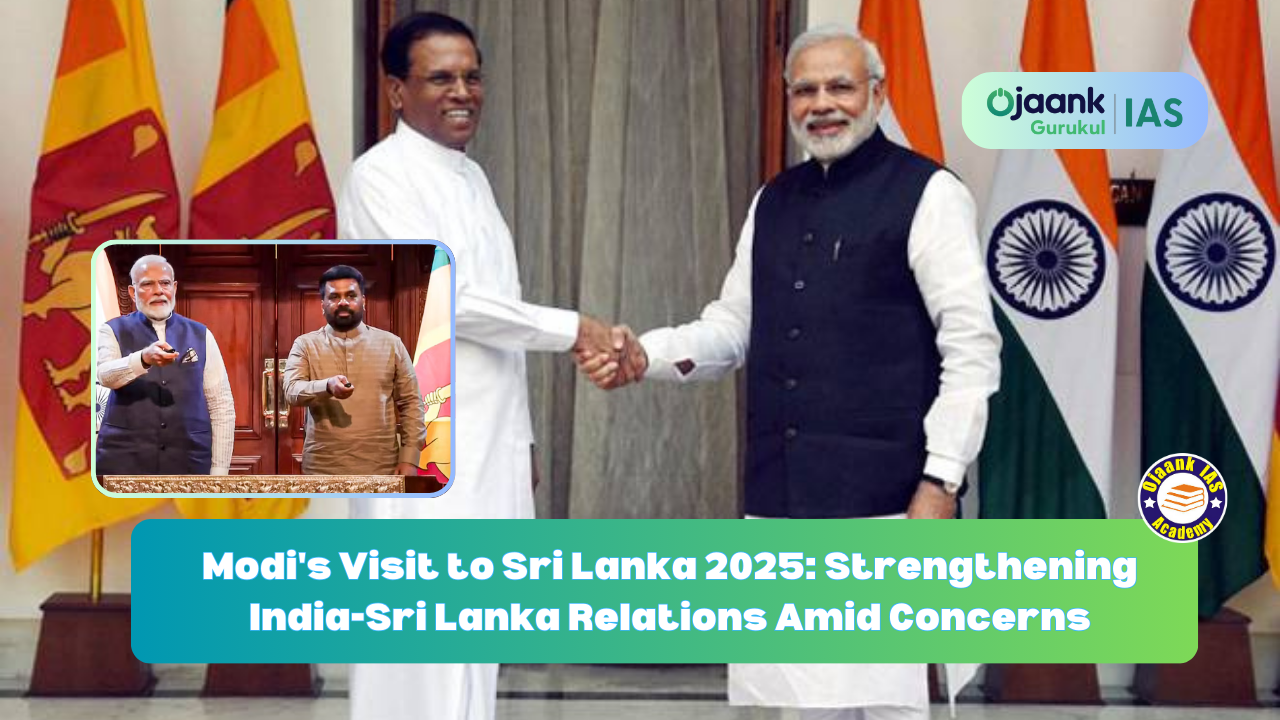Modi's Visit to Sri Lanka 2025: Strengthening India-Sri Lanka Relations Amid Concerns

Introduction: A Strategic Reset, Not Just Symbolism
Prime Minister Narendra Modi’s three-day visit to Colombo from April 4–6, 2025, wasn’t just ceremonial—it was deeply strategic. His presence in Sri Lanka marked a crucial moment for recalibrating ties with a new political leadership in Colombo, dispelling prior anxieties, and laying the foundation for stronger bilateral cooperation.
🌐 Read: India’s Foreign Policy Strategy in 2025 – Explore how New Delhi’s evolving foreign policy is recalibrating ties in South Asia.
This visit, Modi’s first since 2019, took place under the newly elected Janatha Vimukthi Peramuna (JVP)-led National People’s Power (NPP) regime, which had previously been seen with suspicion due to its historically anti-India stance. But things are shifting—fast.
A Symbolic Honour With Strategic Intent
The government of Sri Lanka conferred its highest civilian honour for foreign leaders on Mr. Modi—an unmistakable signal of goodwill and a reset in diplomacy. This move underscores Sri Lanka’s intention to move past ideological baggage and build a relationship anchored in regional cooperation, mutual respect, and strategic trust.
Defence Cooperation: The MoU That Matters
One of the standout deliverables was the landmark MoU on defence cooperation—the first of its kind between India and Sri Lanka. While the full text of the agreement hasn't been made public, it formalizes the growing convergence in security matters, including maritime safety, intelligence sharing, and border monitoring.
Mr. Modi emphasized a critical point: “The security of both countries is interconnected and co-dependent.”
This MoU builds on the 1987 understanding that Sri Lankan ports like Trincomalee will not be used by third countries in a way that threatens India’s strategic interests. However, India still expects Colombo to prove its seriousness, especially with rising geopolitical competition in the Indian Ocean region.
🌐 Learn: Strategic Importance of Trincomalee Port – Why Trincomalee is central to Indo-Lanka security and maritime strategy.
Fishing Dispute: The Human Face of Diplomacy
The Palk Bay fishing conflict—long a thorn in bilateral relations—received deserved attention. Discussions during the visit paved the way for community-led dialogues between Indian and Sri Lankan fishers, a move applauded in Tamil Nadu and Northern Sri Lanka alike.
Recent informal meetings between fishing communities signal hope, but it’s crucial that official, government-backed follow-up talks take place soon. A flexible, empathetic approach from both sides will be key to solving this humanitarian and economic issue once and for all.
🌐 Explore: Tamil Nadu and the Palk Bay Conflict – A closer look at the socio-economic and political dimensions of the dispute.
Tamil Issue and the Indo-Lanka Accord: A Quiet Revival
In a significant yet underreported development, Tamil political parties in Sri Lanka met Mr. Modi and expressed support for the Indo-Lanka Accord of 1987. The Accord—which had once facilitated the creation of provincial councils—was seen as a viable roadmap for political devolution and reconciliation.
These leaders urged India’s legitimate involvement in pushing for a political settlement that ensures dignity, rights, and development for Sri Lankan Tamils. Despite earlier criticisms, there’s growing internal consensus within Sri Lanka on the need to revive the spirit of the Accord, especially in the Northern and Eastern Provinces.
🌐 Understand: The Indo-Lanka Accord of 1987 Explained – Discover how a historic treaty is making a quiet comeback in shaping Tamil reconciliation.
India’s Role: Development Partner, Not Intervener
India has a unique window to step in—not as a regional hegemon but as a dispassionate development partner. New Delhi can:
-
Offer liberal financial aid to rebuild war-ravaged Tamil regions
-
Support capacity-building programs in governance and civil services
-
Empower grassroots democratic institutions in line with the 1987 Accord
What’s needed now is quiet diplomacy, consistent engagement, and a narrative that India stands with the people, not over them.
🌐 Discover: How India is Building Soft Power in South Asia – From language programs to development aid, India is investing in regional trust.
Conclusion: A New Chapter With Strategic Clarity
Prime Minister Modi’s 2025 visit to Sri Lanka should be seen as a strategic investment in regional harmony, not just a diplomatic courtesy. By addressing security, economic, and humanitarian concerns head-on—and forging real partnerships rather than posturing—both nations have an opportunity to redefine South Asian regionalism.
This visit proves that even old challenges can find new solutions—with the right leadership and a shared vision.
Why This Matters for the Region
-
It signals stability amid global turbulence.
-
It renews the relevance of the Indo-Lanka Accord in today’s context.
-
It strengthens defence and maritime security in the Indian Ocean.
-
It amplifies the voice of Tamil communities through democratic channels.
-
It exemplifies mature diplomacy between close neighbors with a complex history.
If you want to stay updated on India’s evolving geopolitical strategy and its impact on the neighborhood, bookmark this blog and follow our analysis.
#IndiaSriLankaTies #ModiInColombo #Geopolitics2025 #IndoLankaAccord #SouthAsiaStrategy